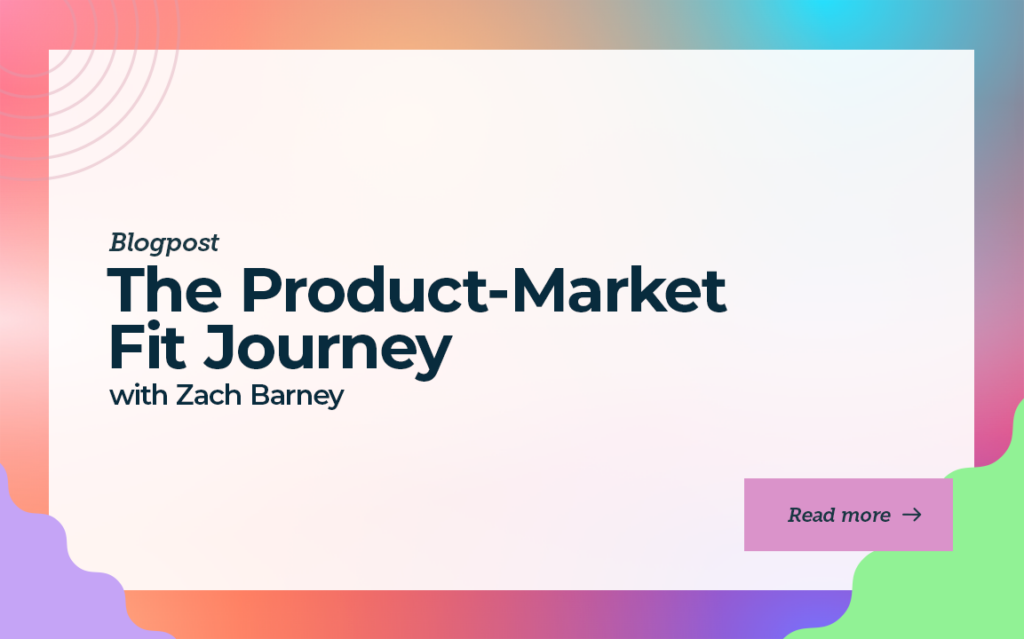The Product-Market Fit Journey with Zach Barney

Every founder starts with a problem. For Zach Barney, that problem was event sales. After years of leading sales teams, attending conferences, and struggling with lead attribution, he realized something: event-driven sales was broken.
“You don’t move up in sales leadership unless you know your numbers,” Zach explained. “But when it came to conferences and trade shows, tracking real impact was a nightmare. Slow, manual, and expensive.”
The turning point? After another frustrating experience of waiting weeks for messy badge scan data, he decided to fix it.
Validating the Idea
The first step wasn’t writing code. It was talking to people. Zach and his co-founder, Kris Jenkins, ran 40 customer interviews with CEOs, heads of marketing, and event directors. The goal? Make sure this wasn’t just their frustration.
The response was overwhelming:
- “Yes, this is a problem.”
- “I would love to see this solved.”
- “When can I try it?”
Encouraged by the feedback, they built a Figma prototype and returned for another round of 30 deep-dive sessions. The result? People were already asking for contracts. Before a real product even existed.
Finding Early Customers
Zach and Kris leaned on their network for the first customer, a former client from 13 years ago who saw the value immediately and signed up on the spot.
Then, they landed their first enterprise deal at an event by literally showing the product in action. While other companies were stuck using fishbowls full of business cards, Mobly had a better way.
From there, growth came from:
- LinkedIn: Both founders were active, posting, and engaging daily.
- Inbound leads: Even a simple website brought unexpected traction.
- Conferences: The biggest driver, attending 15–20 events in just six months, meeting prospects where they felt the pain.
“We weren’t just pitching. People were actively experiencing the problem we solved. That made all the difference.”
Growth Beyond Early Customers
Winning the first few customers is one thing. Sustaining growth is another. Many companies assume early sales mean product-market fit, but the real test comes later. When customers decide whether to stay, expand, or refer others.
Visibility Matters More Than Virality
Posting on LinkedIn worked for Mobly, but not because of engagement metrics. It worked because their buyers (marketers and event teams) were there. Regular updates kept them at the top of their minds, so when prospects felt the pain Mobly had solved, they already knew where to look.
For some industries, LinkedIn isn’t the right platform. Auto shop owners, for example, are more active in Facebook groups. Instead of forcing a channel to work, the focus should be on finding where the right audience already spends time and contributing consistently.
Early Traction Vs. Product-Market Fit
Early traction happens when customers like the idea of a product. Product-market fit happens when they:
- Renew and expand contracts.
- Continue using the product after switching jobs.
- Refer colleagues without being asked.
The strongest signal isn’t a closed deal. It’s when customers make the product part of their long-term workflow.
Scaling Past the First Customers
Mobly didn’t rely on a single acquisition channel. They built growth by:
- Running webinars with industry experts, not product demos.
- Using podcasts to reach prospects already interested in event sales.
- Testing content syndication and ads to scale inbound leads.
Webinars were the most consistent driver. They worked with 50–60 attendees per session because they focused on lead conversion and event follow-up strategies instead of a sales pitch.
Lessons for Sales and Growth Leaders
- Early sales don’t confirm product-market fit. If customers aren’t renewing or expanding, there’s still work to do.
- Being active online is about being findable when needed.
- Choosing the right channel depends on where buyers naturally spend time.
- Demand generation works best when it’s focused on education, not just promotion.
Growth isn’t about one breakthrough tactic. The companies that scale do so by stacking multiple repeatable channels and refining them over time.
Why Event Marketing Needs a System of Record
Most event teams use badge scanners, spreadsheets, and manual follow-ups to track leads. That process is slow, fragmented, and often leaves teams guessing about ROI.
Mobly replaces this with a single platform for:
- Event setup and campaign management.
- Lead capture with custom qualification tags.
- Attribution tracking to measure real impact.
Instead of renting scanners and dealing with delayed data, teams can instantly capture, qualify, and sync leads, turning events into a predictable revenue channel.
For more on how Mobly streamlines event sales, visit GetMobly.com or connect with Zach Barney on LinkedIn.
Conclusion
Mobly scaled by solving a clear problem, validating demand early, and meeting customers where they were. Renewals and expansions, not just early sales, proved lasting value.
The lesson for founders: talk to customers, focus on retention, and build demand by providing value. Sustainable growth comes from consistent execution, not one-off wins.
Early traction is excellent, but sustained growth requires repeatable outbound systems, clear metrics, and the right strategy. That’s where we come in.
Predictable Revenue helps companies:
✔ Build structured outbound processes that generate consistent pipeline.
✔ Refine targeting and messaging to increase response rates.
✔ Scale outreach without burning through leads or missing follow-ups.
If you’re ready to move beyond one-off wins and build a repeatable outbound motion, let’s talk.
NO TIME TO READ?
Listen On:


